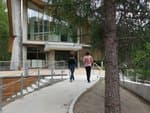Vallouise nordic ski area
Description
Just before the village of Vallouise, turn left towards Puy-Saint-Vincent Station (opposite the pharmacy). Just after crossing the bridge, park in the parking lot in front of the Maison du Parc and the Chalet Nordique.
Information on access and transport is available in the practical info section of our website: https://www.paysdesecrins.com
Parking: We advise you to park at the Maison du Parc and Chalet Nordique when purchasing your Pass at the chalet. Vallouise's cross-country ski trails all start from here.
If you already have your Pass, you can also leave from the parking lot at Pont Gérendoine. From here, a large number of loops are also possible.
A departure is also possible from the Pelvoux resort. From here, four circuits are available. And you can also start from Les Vigneaux, for two circuits.
- Towns crossed : Les Vigneaux, Puy-Saint-Vincent, and Vallouise-Pelvoux
The 2 places of practice to discover
Sensitive areas
Short-toed snake eagle
- Impacted practices:
- Aerial,
- Sensitivity periods:
- MarAprMayJunJulAugSep
- Contact:
- Parc National des Écrins
Julien Charron
julien.charron@ecrins-parcnational.fr
Golden eagle
- Impacted practices:
- Aerial, , Vertical
- Sensitivity periods:
- JanFebMarAprMayJunJulAug
- Contact:
- Parc National des Écrins
Julien Charron
julien.charron@ecrins-parcnational.fr
Short-toed snake eagle
- Impacted practices:
- Aerial,
- Sensitivity periods:
- MarAprMayJunJulAugSep
- Contact:
- Parc National des Écrins
Julien Charron
julien.charron@ecrins-parcnational.fr
Recommandations
→ Cross-country ski trails are groomed, marked and safe. Access is subject to a charge and reserved for Nordic skiers.
→ You use these trails under your own responsibility: find out about weather conditions and trail closures, and don't overestimate your possibilities.
→ Respect the signs: trail directions, dangers, prohibitions, avalanche closures, etc.
→ Dogs are forbidden on cross-country ski trails.
→ Night-time activities and biathlon shooting in the Nordic area must be supervised by a professional.
→ Skiing outside opening hours is dangerous and prohibited (presence of grooming equipment).
→ Take your garbage with you
Tours are available in skating or classic technique.
Winter conditions are very pleasant all day long. However, from March onwards, it's best to practice in the morning, as some of the trails are quickly exposed to the sun.
Don't hesitate to ask for a piste map at the Chalet Nordique in Vallouise or at the Pelvoux lift information point!
Please note : This information is for guidance only. It is your responsibility to check the weather report and conditions before you set off. The Tourist Office and Écrins National Park cannot be held responsible in the event of an accident. In case of doubt, contact professionals: instructors or equipment hire companies.
Mountain Rescue : dial 112
Information desks
23 Avenue de la République, 05120 L'Argentière-La Bessée
Les Alberts, 05290 Puy Saint Vincent 1400 m
Place de l'Eglise, 05340 Vallouise
Vallouise Park house
, 05290 Vallouise
Information, documentation, models, exhibitions, screenings, product sales and works of the Park. Guided tours for school, reservation required. The new Park House opened in Vallouise since June 1, and offers visitors an interactive permanent exhibition inviting to explore the area and its heritage. A temporary exhibition space will allow a renewed offer. Finally, the device is completed by an audiovisual room to organize screenings and conferences Free admission. All animations of the Park are free unless otherwise stated.
50 points of interest
 Know-how
Know-howThe "bua"
Before the year's work began in the fields, the women would spend a special day washing the winter's linen. This was called the "bua". A second was organised in the autumn. The bed linen brought outside to be washed with soap, in cold water. A brief rinse and second wash in soap completed this pre-wash step, called «essangeage». The laundry was then «poured» nto a wooden vat, lined with a coarse canvas.
 Know-how
Know-howThe "coulage" laundry day
The dirtiest linen at the bottom and a large sheet last, which collected the wood ash. The «used» water was collected and reheated several times until the «washing powder» (potash from the ash) had achieved the required standard of cleanliness. Often, a few stems and roots of soapwort were added to give the water a soapy quality. The «coulage» sometimes took up the entire day and the house was filled with a pleasant smell! Finally, the laundry was wheeled on a barrow to the pond for rinsing. Small items were spread out on the blanched grass in the meadow.
 Vernacular heritage
Vernacular heritageBread oven
It is already there on the Napoleonic land register, and was renovated by the town less than 10 years ago with original stone and fire-resistant brick for the vault. Each village had a communal oven saving wood and social ties explain the importance of shared bread baking. Almost a whole month, day and night, between November and December, was devoted to baking bread. The ritual is now carried on in summer baking during religious feast days or other local events.
 History
HistoryLe Poët chapel
A portrait of St-Pancras, the patron saint of the Poët chapel, was once painted on the façade, dressed as a crusader. On his feast day, 12 May, there was a morning mass and we made rice pudding to share with inhabitants from other towns who had journeyed there. Almost two months earlier, the feast of Saint-Joseph was celebrated with a mass in Le Sarret, with families from neighbouring villages invited to eat stew and the traditional rice pudding.
 History
HistoryThe White Penitents
In the 19th century, the White Penitents took part in the religious life of the villages of Le Poët and Le Sarret. All the male villagers were members, and they played a special role during funerals. They first sang the misere in front of the deceased’s house and then accompanied the funeral procession, dressed in hooded habits, with a banner, bell, staves and lanterns. A macabre confraternity whose symbol was a skull and crossbones...
 History
HistoryLe Sarret chapel
Before 1930, the main road passed in front of Le Sarret chapel. Burials took place in Le Poët until the 1940s, when the cemetery was moved to make way for the new road to Pelvoux.
 Know-how
Know-howHemp production
At one time, almost every winter evening would be taken up by stripping the fibre from the hemp straw. The strands had to be broken one by one, to remove the long, flexible filaments. Once washed and combed, these «balls» of hemp were taken to the rope and yarn spinners to be turned into rope, blankets and cloth for garments. When a family ordered cloth from the weaver, the entire family would go to the loom to attach the threads onto the warper.
 Architecture
ArchitectureThe commons
As «crosswise» as it might be, from end to end the main street of Puy-Saint-Vincent has every building the community needs. The mill is still here, complete with its intake and outlet mill races. The communal oven is lit on 14 July every year. It has just been restored and shares the little paved square with a lovely water fountain, made from wood and ringed with iron.
 History
HistoryThe church of Sainte-Marthe
The church of Sainte-Marthe was built in the nineteenth century, in 1817 to be precise, as indicated at the top of the pediment. Only the main facade has a painted decoration. On two superimposed levels and on the gables, pilasters or false pillars frame either bay windows illuminating the nave, or panels painted with a false marble decoration. A few steles remind us of the present of the former cemetery. Included on the Supplementary Inventory of Historical Monuments, this church also contains a commemorative plaque honouring those who fell in the First World War.
 Architecture
ArchitectureSolid architecture
Originally, the environment of the high valleys of the Pays des Écrins offered little space, in which men and animals cohabited. Unlike in Vallouise, where the architecture is a harmonious blend of arcades and decorative elements, the houses in Le Puy retain the rusticity of completely stone-built single block construction with half-hipped roofsprotruding over a drying balcony. This roof extension protects the main facade from bad weather, snow in particular. People can move about under shelter and the firewood store stays dry all winter. This barrel vaulted porch, which shelters the entrance to the main building and the stable, mirrors the Champsaur-Valguademar, «toune» (ground level arcade).
 Architecture
ArchitectureProtective shelter
Separate from the main building and at a distance from the barn, some property owners also have a small building providing safety from the much feared home fires. Here, in the coolness of this outside cellar, they stored ham, cheeses, flour, salt and other foodstuffs, but also whatever the family owned by way of valuables.
 Architecture
ArchitectureSaint-Étienne de Vallouise Church
Listed and protected as an historic monument since 22 October 1913, the church dedicated to Saint Stephen is one of the most beautiful religious edifices in Hautes-Alpes. It is typical of the Romanesque churches in the Briançon region built in the second half of the 15th century, although its exact construction date is still uncertain.
 History
HistoryThe village of Les Vigneaux
In spite of the altitude, the region's dry climate and the local growing conditions of limestone and sediments facing due south made the planting of grapevines possible as far back as the tenth century. The municipality owes its name to the presence of these vineyard operations, which were very significant in the late nineteenth century. The almost simultaneous appearance of the phylloxera aphid and the Briançon train, bringing wine from Provence, spelled the end of this activity here.
 Water
WaterThne Gyronde
No, we're not in south-west France where the Gironde flows! The Gyronde (spelt with a «y»!) is the river that flows between Vallouise and L'Argentière-La Bessée, where it flows into the Durance. It originates from the Gyr and Onde mountain streams which merge in Vallouise.
 Flora
FloraOn the south-facing slope, pine forest
The track passes through a forest of Scots pines, mixed with some downy oak trees. It is a forest typical of those found in the lower south-facing slopes (those exposed to the sun) in the intra-alpine valleys. Vernacular heritage
Vernacular heritageThe hamlet of Parcher
The hamlet of Grand Parcher stands on the alluvial cone formed by the Grand Parcher mountain stream, and on either side of it. It is made up of several old houses and the seventeenth-century chapel of Saint-André. It has two sun dials painted onto its walls. One of them bears the saying HORA INCERTA CUNTIS, ULTIMA MULTIS (This hour is uncertain for all, it is the last hour for many). Food for thought! Flora
FloraThe acanthus-leaved thistle
This is a hot, west-exposed slope with rocky ground. The plant life reflects this situation: the narrow-leaved lavender and acanthus-leaved thistle grow here. The latter looks like a large sun with its very big flower head which quickly turns golden and its leaves radiating out around it. It often used to be hung on house doors... but much better to leave it lighting up the stony meadows! Fauna
FaunaThe trout
But what's the angler angling for? The brown trout of course! This is the mountain fish par excellence, with a streamlined body to withstand the current more efficiently and light brown skin speckled with black and red. It lives in cold, oxygen-rich waters.
 Flora
FloraForest on the water's edge
This small wood is a fragment of the riparian forest: natural forest growing adjacent to a body of water. Reduced everywhere due to urbanisation, this type of forest is made up of alder, willow and oak, and also poplar, birch and aspen, among others Fauna
FaunaThe white-throated dipper
Perched on a rock in the middle of the river, a squat bird with a short tail, brown with a large white bib, bobs up and down with his tail in the air. He then dives and only reappears a few moments later. This is how this bird hunts, diving into the water and then walking against the current along the river bed searching for aquatic insect larvae, small crustaceans or small fish, lifting pebbles with its beak to dislodge them.
 Flora
FloraForest of pine and oak
The path now alternates between cleared areas and forested areas. This forest contains Scots pine (recognisable by its orangey coloured trunk, especially at the top), downy oak (its young branches and leaf undersides covered with a fine down), and larch. The Scots pine and downy oak are very drought-tolerant (it is very limey soil here) and can also withstand low temperatures, and they are typical of the montane zone in this part of the Alps.
 Panorama
PanoramaThe Montbrison massif
The path offers a beautiful overall view of the limestone massif of Montbrison, overlooking the hamlets of Pelvoux with the peaks of the Cime de la Condamine, the Tête des Lauzières, the Pic de Montbrison and the Tête d'Amont.
 History
HistoryThe hamlet of Puy Aillaud
Puy Aillaud is a permanently inhabited hamlet and the highest in Vallouise (1,580 m). This hamlet has preserved some beautiful traditional houses.
 Fauna
FaunaThe rock sparrow
A little flock of rock sparrows can often be spotted around Puy Aillaud. This large sparrow earned its French name moineau soulcie, (sourcil meaning eyebrow) because it has a large white eye-stripe. It also has a dark head, a brown back with white stripes, and a white breast and underside striped with light brown. It has a small yellow throat spot, often not visible. It is a year-round resident.
 History
HistoryThe chapel of Saint-Jean
Surrounded by a cemetery and with a bench installed to the front of its façade, this pretty little seventeenth century chapel has an air of peaceful tranquillity. Maybe to sit and watch the trail runners? Flora
FloraThe downy oak
The route leads down a warm slope, where the downy oak reigns supreme. It is a small oak tree with a twisted growth habit and with marescent leaves, that is to say, they dry out in the autumn but remain on the tree all winter. It is called "downy" because the young branches, buds and sometimes the undersides of its leaves are covered in a fine down. It is a tree that grows happily on the warm dry slopes.
 History
HistoryThe church in Vallouise
The church of Saint-Étienne dates from the fifteenth and sixteenth centuries. Inside is an altarpiece and a tabernacle in gilded wood dating from the eighteenth century, together with come mural paintings. Not far from the church stands the late sixteenth-century Chapel of the Penitents with a nineteenth-century painted facade.
 Fauna
FaunaThe lesser horseshoe bat
In summer, bats take up residence in the church roof. The species living here is the lesser horseshoe bat, which has been in serious decline over recent decades. Every year, the mothers return after hibernating in caves and each one gives birth to one bat pup. Bats are insectivore mammals threatened by the insecticides used on farmland and on wooden structures and the loss of their hunting habitats and roosts, among other things. They are all protected.
 History
HistoryThe Vallouise Park Centre
Vallouise Pelvoux is a municipality within the Parc National des Écrins. Renovated in 2014, the Park Centre ("Maison du Parc") houses the offices of the local Park staff and has a spacious visitor reception area. It offers a permanent interactive exhibition inviting discovery of the territory and its heritage features, a temporary exhibition space on the upper floor and an audiovisual room (screenings and talks). It is currently in the process of applying for the "Tourisme et Handicap" tourism and disability label. Admission is free and so, too, are most of the activities in offer.
 Flora
FloraThe Scots pine
A long trunk that is reddish-brown towards the top, sparse foliage, grey-green needles grouped in pairs... It has to be the Scots pine. Happy in poor soil, this softwood tree can withstand below-zero temperatures as well as summer droughts, and so it is very common in intra-alpine valleys with a continental climate, like the Vallouise.
 Fauna
FaunaThe roe deer
The forest is home to roe deer, which can often be seen. This ungulate (hoofed mammal) is rather unusual because the rut does not take place in autumn, for births in May and June as is the case with other mountain-dwelling ungulates, but in summer. After fertilisation, however, egg development is suspended for 6 months (this is called embryonic diapause). Gestation then resumes so that the fawn (or twin fawns) can be born in spring, a period more favourable for its survival.
 History
HistoryThe Sentier du Facteur - the postman's path
In former times, the postman would take this path every day: He would set out from Vallouise, deliver letters in Puy-Saint-Vincent and drop back down to Vallouise, stopping at the hamlets of Parcher on the way. In the winter, when the snow was too deep, the Traversouires (the inhabitants of Puy-Saint-Vincent) donned their snowshoes and wielded their shovels to clear the postman's path down to Vallouise.
 Fauna
FaunaThe sun bird
So what is the identity of this sun bird? It's the royal, or golden, eagle of course. Although it is telling the time here, in the surrounding natural landscape it hunts marmots. But what becomes of it in winter when the marmots hibernate deep in their burrows? It's a lean time. It has to make do with a hare or ptarmigan, and in particular the carcasses of chamois which have not survived the winter or have been killed in an avalanche.
 Flora
FloraThe ash tree
Even in winter, the ash can be recognised from its large black leaf buds. The leaves are compound. A pioneer species that grows easily, the ash has long been used by man for everyday needs: its foliage was used to feed cattle and its hard, flexible wood was used to make a variety of objects such as tool handles. Its French name frêne often appears in local place names too: Freissinières (frêne noir - black ash), Le Freney etc. Evidence of its historical importance to human communities..
 Fauna
FaunaThe gerris
Some strange creatures are moving jerkily over the surface of the water: Gerrises, insects related to bedbugs. Like a true insect, they have six legs and they «skate» across the water using their intermediate and hind legs which are covered in hairs to make them water-resistant. They are carnivorous and anything on the water surface, dead or alive, is good to eat! They catch their prey with the forelegs, sucking up the juices with their strong proboscis!
 Fauna
FaunaThe wood nuthatch
With its strident calls, this little acrobat gets itself noticed. With a blue-grey back and a black stripe over its eyes, it works its way down the tree trunks upside down in search of insects. It nests in old woodpecker nests but if the diameter of the entrance is too large it reduces it with mud, to protect its young from predators. Hence its French name torchepot (a reference to edging the rim of a vessel).
 Fauna
FaunaMinute snails
If you take the trouble to examine the large boulder, you might discover minute snails just a few millimetres in diameter, clinging to the stone walls. The elongated snails are Chondrina avenacea and the others, which are round and conical, are Pyramidula pusilla. They are common but too seldom observed. Nature is rich; you just have to take the time to observe it with curiosity!
 Flora
FloraThe aspen
Near the ruined mill, you can see a stand of tall trees with smooth, greenish trunks and rounded, crenelated leaves which take on magnificent colours in autumn. The stem, or petiole, of aspen leaves is flat and twisted, so it can be caught by the slightest breeze making the foliage «quake» hence its common name, the quaking aspen. It needs dampish soils and plenty of light and so it grows in clearings.
 Fauna
FaunaThrushes
In the springtime, the woods echo with the song of birds seeking a mate and defending their territory. Among them is the song of the mistle thrush, similar to that of the blackbird, melodious and piping. As for the song thrush, it has a wide and varied repertoire: its song is a succession of powerful varied notes, each repeated numerous times. In summer, the birds are more inconspicuous: when raising young, there's no point in singing for a mate, better not to attract attention!
 Vernacular heritage
Vernacular heritageThe penstock pipe
This penstock pipe carries water to the Le Claux hydroelectric power plant, located just below here, which exploits the water from the Les Écrins massif. The power plant was inaugurated in 1932. At the time, the electricity generated was primarily used to power the aluminium factory located in L'Argentière-La Bessée.
 Architecture
ArchitectureVallouise
Multi-storey houses - typical of the architecture in the valley in the seventeenth and eighteenth centuries - stand on the old village street. The ground floor was reserved for animals, the first floor for habitation and the upper floors for grain storage. People moved from one floor to another by means of balconies interconnected by a staircase. Many of these balconies are arcaded with stone columns. This type of arcaded balcony is found throughout the valley.
 Architecture
ArchitectureLe Villard in Vallouise
Lying in the valley of the Onde, the hamlet of Le Villard is justifiably proud of its beautiful houses with arcaded balconies, of the same type as those of Vallouise. It is a pretty, flower-filled hamlet. It still receives a few hours of sunshine in the winter, which is not the case further along the Onde valley. It stands in a position sheltered from avalanches which are severe in this valley.
 Fauna
FaunaThe Eurasian wren
A piercing song, long and flowing with numerous trills, bursts from the forest. What a pair of lungs! This powerful song is that of a tiny bird with a plump body and a short tail, which is often raised: the Eurasian wren. It lives in cool forests with dense undergrowth or in bushes on the water's edge. It builds a spherical nest, often against a rock or old wall, hence its French name troglodyte.
 Flora
FloraThe sycamore
The sycamore is a beautiful tree. Its leaves have five rather pointed lobes, similar to those of the plane tree. It cannot tolerate drought, so it grows in this region in relatively cool deciduous forests. Its twin fruits, equipped with wings, twist as they fal: the «helicopters» that children love. In autumn, its leaves turn golden yellow creating a delightful sight.
 Flora
FloraRiparian forest
The track runs through a wood of alder, beech, aspen and oak, the remnant of the natural forest growing at the water's edge, called riparian forest. This type of forest is in decline everywhere, destroyed by urbanisation and by containment of the mountain streams. Yet it is an essential zone for the fixation of river banks and for purifying the water. Since it offers specific natural habitats, it also plays a major role in maintaining biodiversity.
 Fauna
FaunaThe long-tailed tit
Some birds are causing a stir in a tree, constantly coming and going and uttering little calls. They are round and black and pinkish beige in colour with a long tails, hence their name, the long-tailed tit. They are resident birds and always live in small groups. They inhabit forests, undergrowth and even gardens. They weave a ball-shaped nest out of lichen, moss and dry grass.
 Flora
FloraThe great globe thistle
On the edge of the path grows a tall plant with quite wide and smooth leaves, and completely round whitish or very pale blue flower clusters. This is the great globe thistle, a relatively rare plant. It is a cousin of the southern globe thistle which can be seen everywhere in dry places. This one is smaller and has clusters of bluish flowers and spiny leaves.
 Flora
FloraThe Montpellier thistle
A large plant grows along the canal side; a sort of thistle although it is not spiky: the Montpellier thistle. Its oval, pointed leaves are edged with large, stiff but non-spiky cilia. Its flowers are pink. In France, it is only found in the Alps and the Pyrenees and a few departments in the south. Associated with wet areas, this species has become rare in many regions because of damage to its habitat.
 Flora
FloraThe aspen
A sizeable aspen grows on the roadside, on the edge of a small wood of fellow-aspens. This tree has a smooth, greenish trunk and rounded, crenelated leaves which take on magnificent colours in autumn. The stem, or petiole, of aspen leaves is flat and twisted, so it can be caught by the slightest breeze making the foliage «quake» hence its common name, the quaking aspen. It grows in places where the soil is quite damp.
 Fauna
FaunaThe Eurasian blackcap
Hidden in the tree foliage, the Eurasian blackcap announces its presence with its loud and piping song. Its head is adorned with a cap which is black in the male and russet in the female. The rest of its plumage is greyish, its underside lighter than its back. It is a migratory bird which travels to the Maghreb to overwinter. However, increasing numbers of birds make only a partial migration, flying to the south of France to spend the winter.
Access
Source





